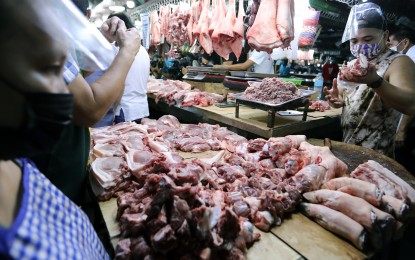
PRICE CAP. Vendors and consumers alike were protected by the price ceiling law that set a cap on pork prices. The Department of Agriculture also tapped its regional offices to send surplus meat products to the National Capital Region. (PNA file photo)
MANILA – The price ceiling set by the government early February was effective in pulling down high retail prices that were manipulated by traders who take advantage of consumers.
Department of Agriculture (DA) Assistance Secretary Noel Reyes told the Philippine News Agency on Friday that the price ceiling is meant to set an ideal range.
As the Executive Order 124 nears expiration (60 days after the February 8 implementation), DA reports indicated not all public markets applied the government-set prices.
"While it was not met, at least the prices were pulled down," Reyes said.
Prices for pork and pork products were highest during the Christmas holiday in 2020. It was not flagged at the time as the DA understood the high demand.
When prices remained high in January 2021, DA Secretary William Dar proposed the Executive Order.
The 60-day law imposed the price ceiling for a kilogram of kasim (pork shoulder) and pigue (pork butt) at PHPP270, PHP300 per kilogram for liempo (pork belly), and PHP160 per kilogram for dressed chicken.
Before the EO was implemented in February 8, some vendors were retailing pork products for as much as PHP400 per kilogram.
In DA's market watch as of Friday, kasim retailed between PHP310 to PHP350 per kilogram; liempo was sold at PHP340 to PHP360; while fully dressed chicken retailed at PHP150 to PHP170.
Reyes shared that while the DA works on controlling the retail prices, it also tapped its regional offices to send surplus meat products to the National Capital Region.
As of Thursday, the DA has already transported 220,481 live hogs to areas in Luzon with high or unmet market demands.
A total of 9,089 hogs and 36,525 kilograms of carcass were delivered from various regions to Metro Manila, a DA report cited.
The largest number of deliveries came from Western Visayas via container ship Ocean Abundance, which experienced delay, arriving on March 25 instead of March 23. The shipment carried a total of 4,470 hogs, comprising 49 percent of the total deliveries on Thursday.
SWINE Financing Program
The DA in partnership with LandBank of the Philippines also recently opened the PHP15-billion Special Window and Interim Support to Nurture Hog Enterprises (SWINE) program to finance the repopulation of the hog industry.
The DA offices will provide LandBank with a list of potential borrowers, and certify that their project locations are within the updated African swine fever zoning map.
DA will also provide training on biosecurity management and breeding/rearing of hogs to interested investors, and provide agribusiness and marketing assistance, among other services.
LandBank lending centers, on the other hand, will conduct program promotion, accept and evaluate loan applications, facilitate approval and release of loan, and collect loan repayments.
Under the lending program, borrowers may avail of a loan, up to 80 percent of the project cost, with a fixed interest of three percent for three years, and thereafter subject to annual interest rate repricing. The loan may be paid up to five years.
Aside from hog production, the loan may be used for related purposes, like acquisition and import of semen or breeding animals; feed milling operations; construction, improvement or retrofitting of facilities in compliance with the DA biosecurity protocols; acquisition of fixed assets; and as working capital.
The SWINE lending program adds up to a host of other DA-LandBank partnerships to sustain the growth, modernization, and industrialization of Philippine agriculture, namely the rice competitiveness enhancement program; rice farmers financial assistance; financial subsidy for rice farmers; and expanded survival and recovery assistance. (PNA)
